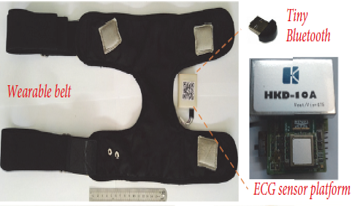Developing a wearable system for telemetric ECG monitoring
Continuous ECG monitoring may be possible using wearable ECG monitoring systems that use textile-based electrodes and interconnections. The electrodes should be positioned in a way that ensures conformal skin-electrode contact in order to gather ECG signals with high signal quality. Moreover, to become an integral part of everyday outfits, such wearable smart clothes are expected to be lightweight, conformable, easy to use, and accurate in measurement.
Individuals can monitor their health conditions at home without visiting the hospital thanks to portable biosignal monitoring gadgets. However, the majority of these technologies require educated professionals to implement them, and the bulky wires make these devices uncomfortable to use for extended periods of time. Over the past 20 years, a number of wearable physiological monitoring devices have been created for the purpose of continually monitoring patients' health conditions (for example, heart performance) when they are out of the hospital and in their own environments. In order to provide early detection of physiological activity and other health indicators without interfering with the patient's everyday activities, wearable sensing systems assist in the daily collecting and processing of multi-parametric health data. The many types of sensors used in wearable health monitoring devices can be incorporated into watches, bracelets, belts, other clothing items, or fabrics. These wearable sensors increase users' ability to actively manage their health as part of a preventive lifestyle that lowers healthcare expenses by identifying health issues early on. Due to the fact that present electronic sensors and electronics are stiff, breakable, bulky, and intrusive and do not allow users to do all daily tasks, textile-based wearable sensors have been attracting significant interest in recent decades. These wearable smart clothing are made up of three main parts: processing units, connectivity wires, and electrodes.
In this study, a wearable ECG monitoring device will be created by incorporating textile ECG electrodes into clothes for patients that need continuous ECG monitoring using telemetric devices. The electrodes must make conformal contact with the skin and apply a consistent amount of pressure in order to acquire an ECG signal with high signal quality. The pressure of clothing on the human body varies depending on where it is applied due to the uneven surface of the human skin. It is crucial to choose the ideal location for the electrodes to be installed in order to achieve conformal skin-electrode contact, where garment pressure fluctuations are minimal and preserve a high value, and contact is not considerably impacted by body motions. As a result, in order to determine where the ECG electrodes should be placed and to make an electrode position hypothesis CLO3D will be to simulate the Garment Stress Maps of the cloth over the human model avatars in order to determine the optimal position that the ECG electrodes should place and to hypothesis a better electrode position.


Contact
Prof. dr. ir Lieva Van Langenhove (Lieva.VanLangenhove@ugent.be)